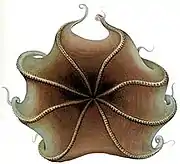| Opisthoteuthis extensa | |
|---|---|
 | |
| Dorsal view illustration | |
| Scientific classification | |
| Domain: | Eukaryota |
| Kingdom: | Animalia |
| Phylum: | Mollusca |
| Class: | Cephalopoda |
| Order: | Octopoda |
| Family: | Opisthoteuthidae |
| Genus: | Opisthoteuthis |
| Species: | O. extensa |
| Binomial name | |
| Opisthoteuthis extensa | |
Opisthoteuthis extensa is a species of octopus found off the west coast of Sumatra, an Indonesian island.[3] It lives at a recorded depth of 768 m (2,520 ft).[4] O. extensa lives in a benthic habitat, like many other cirrate octopuses.[2] It occupies a deep part of the ocean where little sunlight penetrates.
The species has not been studied in-depth; not much is known besides its habitat and anatomical description.[4] It is only known from a single female specimen.[5]
The type specimen, upon which the description is based, has small suckers, small eyes, and arms that do not vary much in length. The fins, which it uses for locomotion, are also very small. O. extensa may be the same species as Opisthoteuthis pluto.[6]
 Oral view illustration
Oral view illustration
References
- ↑ Lyons, G.; Allcock, L. (2014). "Opisthoteuthis extensa". IUCN Red List of Threatened Species. 2014: e.T163399A1004831. doi:10.2305/IUCN.UK.2014-3.RLTS.T163399A1004831.en. Retrieved 20 November 2021.
- 1 2 "Opisthoteuthis extensa Thiele, 1915". World Register of Marine Species. Flanders Marine Institute.
- ↑ M.A. Collins; R. Villanueva (June 13, 2006). "Taxonomy, ecology and behaviour of the cirrate octopods.". In Gordon, J.D.M.; Atkinson, R.J.A.; Gibson, R.N. (eds.). Oceanography and Marine Biology: An Annual Review, Volume 44. CRC Press. p. 297. ISBN 9781420006391.
- 1 2 Jereb, P. (2005). Cephalopods of the World: An Annotated and Illustrated Catalogue of Cephalopod Species Known to Date · Volume 3. Food and Agriculture Organization of the United Nations. p. 255. ISBN 9789251079898.
- ↑ Young, Richard E.; Vecchione, Michael (May 13, 2003). "Opisthoteuthis extensa". Tree of Life Web Project.
- ↑ Robson, G.C. (1929–1932). A monograph of the recent Cephalopoda based on the collections in the British Museum (Natural History). p. 173.
This article is issued from Wikipedia. The text is licensed under Creative Commons - Attribution - Sharealike. Additional terms may apply for the media files.
